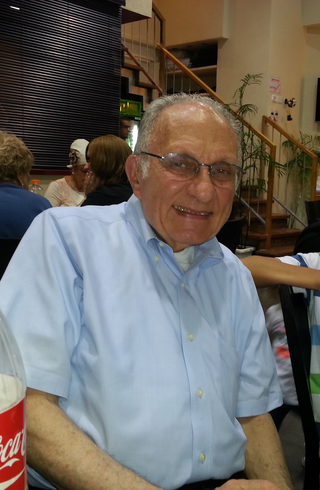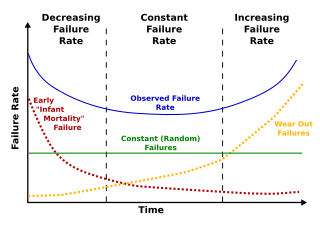Related Research Articles
A randomized algorithm is an algorithm that employs a degree of randomness as part of its logic or procedure. The algorithm typically uses uniformly random bits as an auxiliary input to guide its behavior, in the hope of achieving good performance in the "average case" over all possible choices of random determined by the random bits; thus either the running time, or the output are random variables.
Reliability engineering is a sub-discipline of systems engineering that emphasizes the ability of equipment to function without failure. Reliability describes the ability of a system or component to function under stated conditions for a specified period. Reliability is closely related to availability, which is typically described as the ability of a component or system to function at a specified moment or interval of time.
Probabilistic risk assessment (PRA) is a systematic and comprehensive methodology to evaluate risks associated with a complex engineered technological entity or the effects of stressors on the environment.

Lee M. Spetner is an American and Israeli creationist author, mechanical engineer, applied biophysicist, and physicist, known best for his disagreements with the modern synthesis. In spite of his opposition to neo-Darwinism, Spetner accepts a form of non-random evolution outlined in his 1996 book "Not By Chance! Shattering the Modern Theory of Evolution".
Uncertainty quantification (UQ) is the science of quantitative characterization and estimation of uncertainties in both computational and real world applications. It tries to determine how likely certain outcomes are if some aspects of the system are not exactly known. An example would be to predict the acceleration of a human body in a head-on crash with another car: even if the speed was exactly known, small differences in the manufacturing of individual cars, how tightly every bolt has been tightened, etc., will lead to different results that can only be predicted in a statistical sense.

Probabilistic design is a discipline within engineering design. It deals primarily with the consideration and minimization of the effects of random variability upon the performance of an engineering system during the design phase. Typically, these effects studied and optimized are related to quality and reliability. It differs from the classical approach to design by assuming a small probability of failure instead of using the safety factor. Probabilistic design is used in a variety of different applications to assess the likelihood of failure. Disciplines which extensively use probabilistic design principles include product design, quality control, systems engineering, machine design, civil engineering and manufacturing.
The Applied Probability Trust is a UK-based non-profit foundation for study and research in the mathematical sciences, founded in 1964 and based in the School of Mathematics and Statistics at the University of Sheffield, which it has been affiliated with since 1964.
Statistics, in the modern sense of the word, began evolving in the 18th century in response to the novel needs of industrializing sovereign states.

Computational statistics, or statistical computing, is the study which is the intersection of statistics and computer science, and refers to the statistical methods that are enabled by using computational methods. It is the area of computational science specific to the mathematical science of statistics. This area is fast developing. The view that the broader concept of computing must be taught as part of general statistical education is gaining momentum.

A probability box is a characterization of uncertain numbers consisting of both aleatoric and epistemic uncertainties that is often used in risk analysis or quantitative uncertainty modeling where numerical calculations must be performed. Probability bounds analysis is used to make arithmetic and logical calculations with p-boxes.
The first-order reliability method, (FORM), is a semi-probabilistic reliability analysis method devised to evaluate the reliability of a system. The accuracy of the method can be improved by averaging over many samples, which is known as Line Sampling.
Probability bounds analysis (PBA) is a collection of methods of uncertainty propagation for making qualitative and quantitative calculations in the face of uncertainties of various kinds. It is used to project partial information about random variables and other quantities through mathematical expressions. For instance, it computes sure bounds on the distribution of a sum, product, or more complex function, given only sure bounds on the distributions of the inputs. Such bounds are called probability boxes, and constrain cumulative probability distributions.
P-boxes and probability bounds analysis have been used in many applications spanning many disciplines in engineering and environmental science, including:
Subset simulation is a method used in reliability engineering to compute small failure probabilities encountered in engineering systems. The basic idea is to express a small failure probability as a product of larger conditional probabilities by introducing intermediate failure events. This conceptually converts the original rare-event problem into a series of frequent-event problems that are easier to solve. In the actual implementation, samples conditional on intermediate failure events are adaptively generated to gradually populate from the frequent to rare event region. These 'conditional samples' provide information for estimating the complementary cumulative distribution function (CCDF) of the quantity of interest, covering the high as well as the low probability regions. They can also be used for investigating the cause and consequence of failure events. The generation of conditional samples is not trivial but can be performed efficiently using Markov chain Monte Carlo (MCMC).

Isaac Elishakoff is a Distinguished Research Professor in the Ocean and Mechanical Engineering Department in the Florida Atlantic University, Boca Raton, Florida. He is a figure in the area of mechanics. He has made several contributions in the areas of random vibrations, solid mechanics of composite material, semi-inverse problems of vibrations and stability, functionally graded material structures, and nanotechnology.
Structural reliability is about applying reliability engineering theories to buildings and, more generally, structural analysis. Reliability is also used as a probabilistic measure of structural safety. The reliability of a structure is defined as the probability of complement of failure . The failure occurs when the total applied load is larger than the total resistance of the structure. Structural reliability has become known as a design philosophy in the twenty-first century, and it might replace traditional deterministic ways of design and maintenance.

Deterioration modeling is the process of modeling and predicting the physical conditions of equipment, structures, infrastructure or any other physical assets. The condition of infrastructure is represented either using a deterministic index or the probability of failure. Examples of such performance measures are pavement condition index for roads or bridge condition index for bridges. For probabilistic measures, which are the focus of reliability theory, probability of failure or reliability index are used. Deterioration models are instrumental to infrastructure asset management and are the basis for maintenance and rehabilitation decision-making. The condition of all physical infrastructure degrade over time. A deterioration model can help decision-makers to understand how fast the condition drops or violates a certain threshold.
In the mathematical theory of probability, a generalized renewal process (GRP) or G-renewal process is a stochastic point process used to model failure/repair behavior of repairable systems in reliability engineering. Poisson point process is a particular case of GRP.
Christian Soize is a French engineer and applied mathematician known for his contributions in computational mechanics and uncertainty quantification. He is Full Professor at the Laboratoire Modélisation et Simulation Multi Echelle at Gustave Eiffel University.
References
- ↑ "A Brief History of the Department of Statistics, UNSW" (PDF). University of New South Wales.
- 1 2 "Avraham M. Hasofer - המרכז האקדמי לב". www.jct.ac.il. Archived from the original on 8 January 2019. Retrieved 8 January 2019.
- 1 2 "Prof. R' Avraham Michoel HaSofer, OB"M - Shturem.org Taking The World By Storm". www.shturem.org.
- ↑ Elishakoff, Isaac. Safety Factors and Reliability: Friends or Foes? Springer Science & Business Media, 2012.
- ↑ Fixel, Hedi (1994). "Hobart Hebrew Congregation: 150 Years of Survival Against All Odds".
- ↑ "Yohrtzeit of R' Avrohom Michoel Hasofer OB"M - Shturem.org Taking The World By Storm". www.shturem.org.
- 1 2 Hasofer, A.M. "A Statistician Looks at Neo-Darwinism." B'Or Ha'Torah Vol. 3. (1983): 13-21.
- ↑ R Lidl and D Elliott. "Mathematics for 2015". Voices of a University: Celebrating 125 years at the University of Tasmania (PDF). University of Tasmania.
- 1 2 3 Porush, Israel (1982). "The Canberra Jewish Commnuity (1951-1981)". Australian Jewish Historical Society Journal. 9 (3). Retrieved 12 April 2022.
- ↑ "List of former Professors and senior officers - UNSW Sydney". www.unsw.edu.au. Archived from the original on 10 March 2016. Retrieved 10 January 2019.
- ↑ Dudzik, A., and U. Radoń. "The reliability assessment for steel industrial building." Advances in Mechanics: Theorectical, Computational and Interdisciplinary Issues (2016): 163-166.
- ↑ Huang, Jinsong, and D. V. Griffiths. "Observations on FORM in a simple geomechanics example." Structural Safety 33, no. 1 (2011): 115-119.
- ↑ Choi, Chan Kyu, and Hong Hee Yoo. "Uncertainty analysis of nonlinear systems employing the first-order reliability method." Journal of Mechanical Science and Technology 26, no. 1 (2012): 39-44.
- ↑ Reis, Maria Teresa Leal Gonsalves Veloso. "Probabilistic assessment of the safety of coastal structures." PhD diss., University of Liverpool, 1998.
- ↑ Worsley, Keith J. "Estimating the number of peaks in a random field using the Hadwiger characteristic of excursion sets, with applications to medical images." The Annals of Statistics 23, no. 2 (1995): 640-669.
- ↑ Eidelberg, P. "Codes of the Torah: In the defense of seriousness." B'Or Ha'Torah. Volume 9. 1995.
- ↑ BDD, Bekhol Derakhekha Daehu: Journal of Torah and Scholarship. Issues 14-17. 2004.
- ↑ Hasofer, A. M. "A simplified treatment of Spetner's natural selection model." Journal of Theoretical Biology 11, no. 2 (1966): 338-342.
- ↑ Hasofer, A. M. (1993) Codes in the Torah: A Rejoinder. B'Or Ha'Torah, 8E, 121-131.
- ↑ A. M. Hasofer (1997). "Torah Codes: Reality or illusion".
- ↑ Hasofer, A. Michael. "A statistical critique of the Witztum et al. paper." (1998).
- ↑ Hasofer, Abraham M. "Studies in the history of probability and statistics. XVI. Random mechanisms in talmudic literature." Biometrika (1967): 316-321.
- ↑ A. M. Hasofer, “Some aspects of Talmudic probabilistic thought,” Proceedings of the Association of Orthodox Jewish Scientists 2 (1969): 63–80.
- ↑ Sheynin, Oscar. "Stochastic Thinking in the Bible and the Talmud." Annals of Science 55, no. 2 (1998): 185-198.
- ↑ McDonald, James B. "Statistical Distributions: How Deviant Can They Be?." Brigham Young University Studies 28, no. 1 (1988): 83-121.
- ↑ Rabinovitch, Nachum L. "Studies in the History of Probability and Statistics. XXII: Probability in the Talmud." Biometrika 56, no. 2 (1969): 437-441.
- ↑ "CERRA Awards". International Civil Engineering Risk and Reliability Association. Retrieved 12 April 2022.